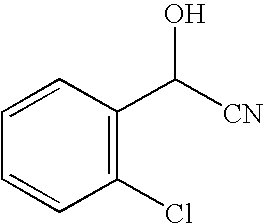Method for producing chiral alpha-hydroxycarboxylic acids by enzymatic hydrolysis of chiral cyanohydrins
a technology of cyanohydrin and enzymatic hydrolysis, which is applied in the direction of enzymes, biochemical equipment and processes, lyases, etc., can solve the problems of decomposition of sensitive substrates and occurrence of corrosion
- Summary
- Abstract
- Description
- Claims
- Application Information
AI Technical Summary
Benefits of technology
Problems solved by technology
Method used
Image
Examples
example 1
Production of the Biocatalyst
[0057] For the production of biomass of Rhodococcus erythropolis NCIMB 11540, a complex standard medium (medium A, see Table 1) was used. The strains were maintained on agar plates using medium A (solidification using 15 g / l of agar). The plates were sealed by lateral wrapping with parafilm and stored in a refrigerator at 4° C.
[0058] Growth of the liquid cultures was performed in 1000 ml conical flasks having chicanes using 250 ml of medium A at 30° C. and 130 rpm.
[0059] Variant I (without preculture): About half of the biomass of an agar plate was suspended in 5 ml of sterile physiological common salt solution. One cell suspension was added to 250 ml of culture medium.
[0060] Variant II (with preculture): For the preculture, some biomass of an agar plate was suspended in 5 ml of sterile physiological common salt solution. One cell suspension was added to 100 ml of culture medium (=preculture). After growth for 20-24 h, 5 ml of this preculture was add...
example 2
Reactions Using Lyophilized Cells on an Analytical Scale
[0062] 31.6 mg, 52.6 mg and 105.2 mg of lyophilized cells were rehydrated in 10 ml of phosphate buffer (50 mM, pH 6.5) for approximately 1 hour at 130 rpm and 20-25° C. 475 μl aliquots of this cell suspension were transferred to 1.5 ml Eppendorf reaction vessels and admixed with 25 μl of an approximately 200 mM substrate solution of 2-hydroxy-4-phenylbutyronitrile in DMSO (3 mg, 5 mg and 10 mg of cells / ml, substrate concentration approximately 10 mM, 5% DMSO). The reaction was carried out in the Thermomixer at 30° C. and 1000 rpm. After 0, 2, 4, 6, 8, 10, 15, 20, 30, 60 and 120 minutes, in each case one Eppendorf reaction vessel was admixed with 0.5 ml of 1N HCl. After centrifugation (5 min, 13 000 rpm) and corresponding dilution, the concentrations of cyanohydrin, hydroxyamide and hydroxy acid were determined by HPLC.
TABLE 2Hydrolysis of 2-hydroxy-4-phenylbutyronitrile by lyophilizedRhodococcus erythropolis NCIMB 11540 cell...
example 3
Enzymatic Hydrolysis Using Resting Cells and Lyophilized Cells
[0063] The biocatalyst was produced in a similar manner to Example 1, Variant 1,2 culture flasks. After 20 hours (OD546=3.5 and 1.8), cells were centrifuged off from 4 times 10 ml aliquots of fermentation broth and washed once with K / Na—PO4 buffer (pH 6.5, 50 mM). Two of the cell samples were lyophilized before activity determination, and the other two were used as resting cells.
[0064] The cells were resuspended in 1.8 ml K / Na—PO4 buffer (pH 6.5, 50 mM) (lyophilized cells were shaken for 1 h for rehydration). The reaction was started by adding 200 μl of a 200 mM substrate solution in DMSO (substrate concentration approximately 20 mM) and carried out at 30° C. and 130 rpm in the shaking cabinet. After 30 min, 60 min and 17 h, 200 μl were withdrawn and admixed with 200 μl of 1N HCl. After centrifugation (5 min, 13 000 rpm) and dilution, the conversion rates were determined by means of HPLC. Only the substrate and the two ...
PUM
| Property | Measurement | Unit |
|---|---|---|
| Temperature | aaaaa | aaaaa |
| Temperature | aaaaa | aaaaa |
| Percent by volume | aaaaa | aaaaa |
Abstract
Description
Claims
Application Information
 Login to View More
Login to View More - R&D
- Intellectual Property
- Life Sciences
- Materials
- Tech Scout
- Unparalleled Data Quality
- Higher Quality Content
- 60% Fewer Hallucinations
Browse by: Latest US Patents, China's latest patents, Technical Efficacy Thesaurus, Application Domain, Technology Topic, Popular Technical Reports.
© 2025 PatSnap. All rights reserved.Legal|Privacy policy|Modern Slavery Act Transparency Statement|Sitemap|About US| Contact US: help@patsnap.com



